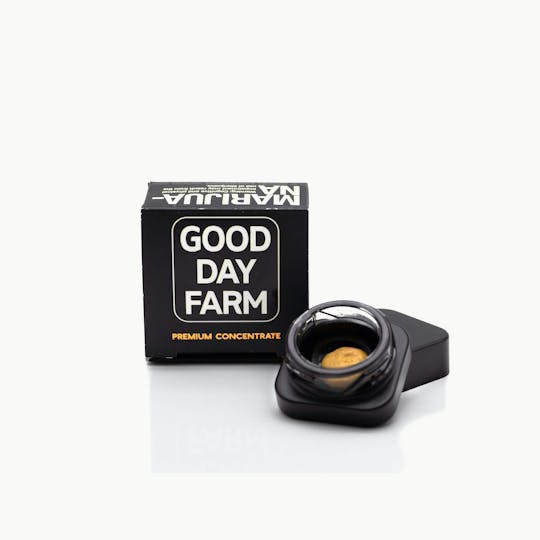
GDF: Concentrate | Durban Poison | Sugar | 1g
Good Day Farm Cured Concentrates are made by extracting all the desirable parts of our premium cannabis plants that have been dried and cured. These concentrates are full spectrum and packed with potency and flavor. Dabbing our concentrates or topping off your joint, blunt, or bowl are the most popular ways to consume. *For peak performance, refrigeration is recommended.
Good People. Good Concentrates. Good Day.
- Earthy
- Woody
- Spicy/Herbal
Inspired by a beautiful farm and the Southern communities that raised us, GOOD DAY FARM was created with the intention to illuminate the GOOD in everyone, everywhere, every day.
At GOOD DAY FARM, we believe in plants > pills (plants over pills) and the magic of mother nature to help people feel their best. This belief drives our relentless quest to cultivate and curate the highest quality cannabis products in the South—while using natural and sustainable practices and giving back to our local communities.
As the self-declared Southern ambassadors of cannabis, we pride ourselves in staying true to our roots as we bring the best the cannabis world has to offer to the places we love most. From our high-tech, high-touch growing practices to our expert extraction methods, everything we do here at GOOD DAY FARM is rooted in our desire to cultivate goodness. Because, at the end of the day, we all just want to feel good.
So, here’s to good people, good cannabis, and more GOOD DAYS!
Durban Poison has deep roots in the Sativa landrace gene pool. The strain’s historic phenotypes were first noticed in the late 1970s by one of America’s first International strain hunters, Ed Rosenthal. According to cultivation legend, Rosenthal was in South Africa in search of new genetics and ran across a fast flowering strain in the port city of Durban. After arriving home in the U.S., Rosenthal conducted his own selective breeding process on his recently imported seeds, then begin sharing. Rosenthal gave Mel Frank some of his new South African seeds, and the rest was cannabis history.
Frank, who wrote the “Marijuana Grower’s Guide Deluxe" in 1978, modified the gene pool to increase resin content and decrease the flowering time. In search of a short-season varietal that could hit full maturation on the U.S. East Coast, Frank’s crossbreeding efforts resulted in two distinct phenotypes, the “A” line and “B” line. The plant from Frank’s “A” line became today’s Durban Poison, while the “B” line was handed off to Amsterdam breeder David Watson, also known as “Sam the Skunkman.”
Durban Poison has a dense, compact bud structure that’s typical of landrace Indica varieties, but the flowers’ elongated and conical shape is more characteristic of a Sativa.